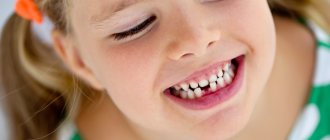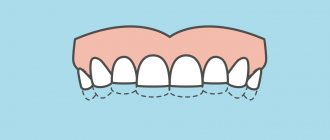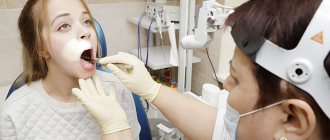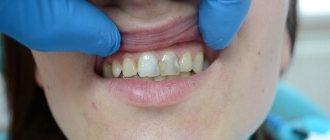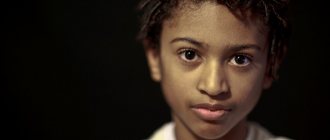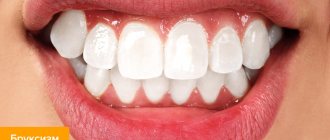Most children have their first teeth at 6-8 months. And when we see that a newborn baby has these “pearls” in his mouth, we are sincerely surprised. Indeed, the so-called natal teeth in newborns occur 1 time per 2-3 thousand crumbs. By the way, this phenomenon occurs much more often in girls than in boys.
Natal teeth are teeth that a baby develops in utero and are already present at birth. As a rule, parents observe two lower front teeth in the child’s mouth at birth. Neonatal teeth appear in a child in the first month of life.
Historians claim that Napoleon Bonaparte, Louis XIV, Julius Caesar, Charlemagne and other great people were born with natal teeth.
Are natural teeth dangerous?
In 95% of cases no. Natal and neonatal incisors are ordinary baby teeth that a child develops in the womb. The main feature of such teeth is that they usually fall out at 3-4 years.
However, natural teeth bring a lot of inconvenience to mother and child. Firstly, during feeding, the mother constantly experiences pain, because the baby unknowingly injures her nipples with his teeth. Secondly, the incisors damage the baby’s gums, frenulum and tongue. The baby develops cracks and ulcers in his mouth, the baby suffers, becomes capricious, and often cries. But, most importantly, if there are ulcers in the mouth, the child can easily get an infection on his own.
In approximately 5% of cases, natal teeth are additional. These supernumerary incisors form in the fetus on top of the baby tooth buds. This means that they will fall out very soon, leaving room for the incisors.
What types of teeth do children have at birth?
The teeth found in the oral cavity of a newborn child may be complete or spare. Regardless of the variety, such teeth are characterized by inferior structure, softness, weakness and rapid wear.
Depending on the variety, “early” teeth also have certain characteristics:
- The eruption of complete teeth
occurs during the baby’s intrauterine development. Their main drawback is represented by the weakness of the structure. These bone structures deteriorate and wear down very quickly and most often fall out before the child reaches the age of four, causing a lot of inconvenience to caring parents and the child. The main inconveniences are associated with the inability to ensure normal breastfeeding of the child, because the woman will constantly face injury to her nipples. Sharp teeth in a child’s mouth can also be the cause of regular disruption of the integrity of soft tissues, accompanied by the formation of ulcers and wounds. - Spare teeth
are represented by an additional row of milk teeth, the formation and eruption of which also occurs during intrauterine development. Most often, spare teeth fall out soon after the baby is born, but they can also remain for a long period. In this case, they most often resort to removing these teeth so that a full-fledged dentition can be formed. Spare teeth also cause a lot of inconvenience, limiting normal feeding and causing many wounds and ulcers in the baby’s mouth.
Why do natural teeth appear?
Most dentists associate the appearance of natal teeth with the processes that occurred during pregnancy:
- unbalanced nutrition when carrying a baby;
- superficial presence of rudiments in the fetus;
- infectious diseases of a pregnant woman with high fever;
- excess calcium and vitamin D;
- diseases of the endocrine system;
- long-term exposure to toxins;
- a woman taking illicit drugs in the first trimester of pregnancy;
- congenital pathologies of the fetus;
- unfavorable environment.
Natal teeth are diagnosed immediately at the birth of the child during an examination in the maternity hospital.
It has also been recorded that children are born with natal teeth suffering from the following pathologies:
- Ellis-Van Creveld syndrome. Genetic pathology of the fetus, which is characterized by growth retardation, disproportionate dwarfism and abnormal growth of all types of bone tissue.
- Hallerman-Streiff syndrome. Many anomalies that appear due to disturbances in the visceral mesoderm of the embryo. Dysmorphia of the maxillofacial part of the skeleton.
- Sotos syndrome. A congenital, sporadic disease in which the child grows very quickly. The pathology is also characterized by accelerated development of teeth.
- Craniofacial type of synostosis. Premature closure of cranial sutures, deformation and limitation of the volume of the skull.
- Multiple steatcystoma. A benign neoplasm characterized by multiple cystic nodules on the skin.
- Cleft in the sky. The palatal parts do not fuse, a congenital disease.
- Congenital pachyonychia. A genetic disease that affects the nail plates.
- Robin's syndrome. A disease characterized by underdevelopment of the mandibular bone, palatal clefts and recessed tongue.
A child was born with teeth: photo - why and what does it mean?
Is it possible to have a baby with teeth? Invented myth or reality? This is an amazing and extraordinary event, so from the first days of life such a child is surrounded by an aura of mystery, surprising the people around him. Doctors in all countries have so far been unable to explain this phenomenon. There is no way to predict whether a baby will be born with teeth or not, it is just a matter of chance.
Are children often born with teeth?
Often, only after six months does a child begin to erupt a tooth, but if it appears at least three or four months, then it is considered that these are early teeth. There are unique children who are born with teeth, while others erupt teeth within the first 30 days of life. Approximately one baby out of several thousand is born with one tooth, much less often - with two.
The lower teeth are most often congenital; in most cases they are not at all strong, they can become loose, and if they are not removed, they will soon fall out on their own. However, there are also exceptional cases when congenital teeth are very strong and remain until replaced by molars.
Causes of early tooth growth
The formation of all vital organs in a child, not excluding the formation of teeth, occurs in the first few months of pregnancy. During development, minerals accumulate in the tooth buds, a vascular network and nerve endings are formed. The tooth grows, matures and erupts. The time of teething, the structure and health of a child’s teeth may depend on the following factors:
- taking medications during pregnancy that can affect the formation of tooth buds;
- metabolic processes, hormonal balance and the presence of endocrine abnormalities in the expectant mother and baby;
- ecological situation;
- genetic predisposition;
- lifestyle of the expectant mother;
- the mother's calcium and vitamin D levels are within the established norm for a pregnant woman;
- mother's nutrition during pregnancy, etc.
The most common theory for teeth appearing prematurely is based on the genetics of the embryo. This may also be due to excessive accumulation of calcium and vitamin D during pregnancy in the mother.
Features of natal teeth
The teeth that erupt in the baby inside the mother’s womb are called natal, and those that appear within a month after birth are called neonatal. Only in 5% of cases are these additional, supernumerary teeth; in the rest, these are the first incisors. This phenomenon occurs more often among girls than among males.
Regardless of their location, these teeth are smaller, with plastic enamel, prone to various damages, they can look like in the photo (see also: polyodontia in humans: photo, causes of the anomaly).
Despite the fact that natal (neonatal) teeth have no connection with physiological or mental acceleration, this phenomenon can have a rather negative impact on the development of the jaw bone and almost the entire facial skeleton.
- If the neonatal teeth are firmly attached to the bone and do not affect the bite, then they are left.
- If the doctor determines that the teeth that appear are spare (additional) teeth, then they are removed. In order to prevent them from unexpectedly entering the respiratory tract during prolapse.
- If neonatal teeth are weak, shaky, have a dangerous sharp chip (edge), and develop with malocclusion, then they need to be removed.
Caring for your natal teeth
The complexity of the decision lies in the fact that it is not always possible to accurately determine which teeth the child has grown, complete or spare. In some cases, fluoroscopy is necessary for diagnosis, which is sometimes unacceptable for an infant.
A clinical examination consists of several stages, based on the results of which the doctor assesses the condition of the tooth and makes a decision to preserve or remove it:
- Assessment of the mobility of the tooth, its color and shape.
- Examination of gums and tongue. Check for granulomatous lesions, inflammation and damage from sharp edges of the tooth.
- If necessary, referral for consultations with specialists, tests, various diagnostics.
Each child is unique in his own way, and sometimes surprising and difficult to explain phenomena occur in nature. The birth of a baby with teeth can be completely explained; for this you just need to contact a qualified dentist.
Classification
Natal and neonatal teeth were classified by Veronica Habling. The basis for the maturity of incisors is the quality of dental tissue, as well as the degree of its development.
Today there are four categories of natal elements:
- 1st category. The crown is shaped like a shell. The teeth have no roots, the incisors are barely fixed by the gums.
- 2nd category. Characterized by dense crowns and a very weak root structure. Often the roots of the teeth are completely absent, the tooth is weakly fixed in the alveolus.
- Category 3. The incisal edge of the tooth breaks through the gum slightly. The main part of the tooth is located inside the jaw bone.
- Category 4. The teeth can be easily felt, but are hidden by swollen tissues and are invisible to the eye.
What can affect the timing of teething?
- hereditary factors (if the parents’ eruption pattern was disrupted);
- maternal smoking and other bad habits;
- diseases suffered during pregnancy, as well as chronic diseases of the mother and father;
- timing of the birth of the child (prematurity, late birth);
- the course of the birth process;
- ARVI and other diseases that the child suffered during the first months of life;
- method of feeding (breast or artificial).
Diagnostics
As we have already said, diagnosis of natal teeth is carried out at the birth of the child. The doctor conducts a full clinical examination of the baby’s condition, evaluates the characteristics of the teeth and determines the cause of their appearance.
During the initial visual examination, the pediatrician assesses:
- mobility of incisors and their hardness;
- dental anatomy - matching the shape, color and size of the teeth;
- presence of root (if possible). If a tooth is mobile, most likely its root system is not developed or underdeveloped. It will most likely fall out on its own within a few weeks.
The doctor also conducts a mandatory examination of soft tissues:
- Examines the surface of the tongue and gum tissue. The pediatrician identifies the presence of granulomatous lesions and inflammation caused by irritation from the cutting edge of the tooth. If there is a risk of infection, the doctor advises not to save the incisors.
- Performs a general examination of the patient to exclude infections and other diseases. If necessary, the doctor prescribes a series of tests for the patient, recommends undergoing diagnostic examinations and obtaining consultations with specialists.
Folk sign
Among the people, the birth of a child with teeth is often considered a sign of good health and a happy, comfortable life. Rumor has it that "toothy" babies are strong individuals who will be able to stand up for themselves.
However, there is another opinion that promises poor health for a child born with teeth. According to this sign, the baby’s strength “gone” into his teeth.
Everyone decides for themselves whether to believe the signs, but, according to doctors, the health of children is more influenced by the presence of teeth, and a balanced diet, clean air and the love of their parents.
The eruption of a child's first teeth is greeted with joy by all parents. Usually the lower incisors appear first, at 5-7 months of age. This means that the baby is developing normally, is ready for complementary feeding and no longer suffers from itchy gums. Situations where children are born with teeth can cause fear in the mother and surprise in the doctors. There is no need to panic, this phenomenon is episodic and usually does not pose a threat to the child’s health.
The formation of the baby's gums begins in the first trimester of pregnancy. At the same time, the rudiments of teeth are formed. As they grow, undergoing a process of mineralization, they become stronger and covered with thin enamel. By the end of the third trimester, there are 20 baby teeth in the bone tissue of the fetal jaws that have not erupted outward.
Typically, the next stage of odontogenesis - protrusion beyond the gum - begins after birth, on average after 6 months. If the appearance of the first incisors occurs at 3-4 months, then they are called early. Sometimes the timing of teething does not correspond to average standards, and this happens in the womb or in the first month of the baby’s life.
Can a baby be born with teeth?
Yes, the phenomenon is called natal teeth. Mostly the lower central incisors are pecked, less often the lateral ones. And usually a couple performs at once. If teething occurs in the first 28-30 days of a newborn’s life, they speak of neonatal teeth.
Modern medicine views the situation as a deviation from the norm. According to various sources, statistics range from 1:700-30,000 births. On average, it is generally accepted that the birth of children with teeth occurs once every 2000-3000 cases. In boys, this developmental anomaly is observed somewhat less frequently than in girls.
In their structure, natal incisors differ from ordinary primary incisors. They are quite mobile, have an immature root and are attached to the gum by soft tissue. In more than 90% of cases, teeth from birth are milk teeth that appeared prematurely in the womb, that is, complete ones. And only in 1-10% are they supernumerary or additional, spare.
Normally, baby teeth precede molars. When diagnosing natal supercomlets, they are first replaced by milk ones and only then by permanent ones.
Indications for removal of natal teeth
Unusual early incisors should be removed if the doctor notices:
- The edges of the teeth are too sharp;
- Significant mobility of teeth (absence and underdevelopment of roots);
- Weakened incisor structure;
- Thin, discolored tooth enamel;
- Irregular shape of “pearls”.
If natal teeth have at least one of the problems listed above, they can injure the soft tissues of the oral cavity and mucous membranes. Moreover, teeth with weak roots can fall out at any time and fall into the respiratory tract, which is dangerous for the baby’s life.
Composition of saliva
When parents complain about bad teeth, they often do not realize that the cause may be the composition of saliva, which determines heredity. It may vary in the ratio of mineral and organic components. And this has a direct impact on dental health.
With a reduced content of oligosaccharides in saliva, the population of microorganisms increases, which settle on the surface of the enamel, creating a predisposition to caries. To avoid this disease, you need to brush your teeth at least twice a day and use special mouthwashes.
An increase in the concentration of class A immunoglobulins (IgA) in saliva, which have an antibacterial effect, protects the enamel from cariogenic bacteria.
The specialists of the Shifa clinic will help you choose toothpaste and other hygiene products to create the right environment in the oral cavity. Dentists will also give recommendations on diets that reduce the negative effects of saliva.
Preservation of teeth
Most often, natal teeth do not have any negative consequences for the child. The baby was just born special. If the parents and the doctor decide to preserve the incisors, it is worthwhile to be attentive to his oral cavity from the very first day of the child’s life.
Early teeth, much more than baby teeth, require careful care and attention. The child should be regularly shown to the dentist to have the oral cavity cleaned of bacteria.
An ideal care product and method for massaging fragile children's gums and, accordingly, natal teeth are Asepta Baby wet wipes, intended for children from 0 to 3 years old. Finger wipes prevent the growth of bacteria in the oral cavity, reduce discomfort during the eruption of subsequent baby teeth and perfectly clean all surfaces of the oral cavity.
So, now you know how to take care of a baby who was born with teeth. Don’t forget that there is a popular saying: if a child is born with incisors, a happy, rich life awaits him. The baby will grow up brave and strong, and will always be able to stand up for himself!
Should I worry?
There are currently no strict limits on teething. There are teething charts and they reflect the situation that occurs most often. According to this schedule, the lower incisors appear first at the age of approximately 4-5 months; in some cases, the timing of their eruption can extend to 10-12 months.
However, teeth can appear much earlier. If you notice early teeth in your baby, you should not panic; most likely, this feature does not mean anything terrible, but this is a reason to immediately consult a doctor. Only a doctor can give an accurate diagnosis and instructions for further actions.
You may also be interested in
CHILDHOOD
Finger wipes from 0 to 3 years ASEPTA BABY
For gentle oral hygiene of babies and massage of gums during the eruption of the first teeth
More about the product
CHILDHOOD
Children's gel toothpaste from 0 to 3 years ASEPTA BABY
Designed for gentle care of baby's gums and baby teeth
More about the product
Doctor Komarovsky's opinion
Dr. Komarovsky is also studying the question of whether a child can be born with teeth, who notes that deviations of 6 months in the established time frame, both upward and downward, are considered an acceptable norm.
However, the specialist insists on a mandatory visit to the dentist if teething is very late and there is an uncharacteristic localization of developing baby teeth. The doctor also considers the appearance of teeth before birth to be situations that require additional study.
Important! All of the above deviations may be associated with dangerous pathological processes in the baby’s developing body, and therefore should not be left without due attention. Only a specialist will be able to exclude dangerous deviations and prescribe timely and effective treatment, if necessary.
Now you know for sure whether children are born with teeth and what this may be connected with, but if such an anomaly is identified, you should not worry, because most often it is a minor deviation from the norm that can be easily corrected.
